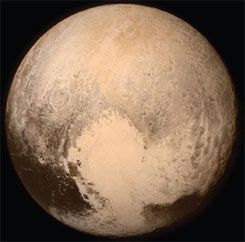 SPACE// Nine years after it left our planet, space probe New Horizons has safety reached its destination – the dwarf planet Pluto, which is at the far end of the solar system. To get there, the probe has travelled 3 billion miles at a dizzying speed of 34,000 miles per hour.
SPACE// Nine years after it left our planet, space probe New Horizons has safety reached its destination – the dwarf planet Pluto, which is at the far end of the solar system. To get there, the probe has travelled 3 billion miles at a dizzying speed of 34,000 miles per hour.
On July 15, New Horizons whizzed past Pluto, after safety clearing the Kuiper Belt, an area in space that is filled with rocks and other debris (remains/rubble) of the solar system. It was the first spacecraft to reach Pluto, and the United States (US) has become the first country to send a mission to all eight planets in the classical solar system (Pluto was traditionally considered a planet. It was demoted to dwarf planet status months after the probe launched in 2006).
New Horizons was launched by US space agency NASA. The probe reached within 7770 miles of Pluto’s surface. The probe carries machines and instruments for capturing images and information about the dwarf planet. A lot of the data has already been captured but it will take around 16 months to download due to the slow connection over the very long distance between Earth and the probe.
Images beamed back from New Horizons so far have shown Pluto in shades of red and orange, with hints of valleys, mountains and craters. Other measurements taken by the probe have found that Pluto is larger than previously thought, at 1,470 miles across. That means it contains more ice beneath its surface and less rock than scientists had anticipated.
After its Pluto flypast, New Horizons will continue its mission into the Kuiper belt. The spacecraft is powered by a nuclear generator that runs on plutonium, a substance named after the dwarf planet and this power source can run the probe until the 2030s, when New Horizons will be 100 times further away from us than Earth is from the sun.
